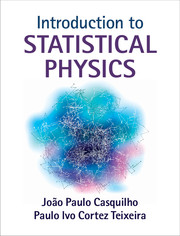Book contents
- Frontmatter
- Dedication
- Contents
- Preface
- Acknowledgements
- 1 Random walks
- 2 Review of thermodynamics
- 3 The postulates of statistical physics. Thermodynamic equilibrium
- 4 Statistical thermodynamics: developments and applications
- 5 The classical ideal gas
- 6 The quantum ideal gas
- 7 Magnetism
- 8 The Ising model
- 9 Liquid crystals
- 10 Phase transitions and critical phenomena
- 11 Irreversible processes
- Appendix A Values of some fundamental physical constants
- Appendix B Some useful unit conversions
- Index
- References
2 - Review of thermodynamics
Published online by Cambridge University Press: 18 December 2014
- Frontmatter
- Dedication
- Contents
- Preface
- Acknowledgements
- 1 Random walks
- 2 Review of thermodynamics
- 3 The postulates of statistical physics. Thermodynamic equilibrium
- 4 Statistical thermodynamics: developments and applications
- 5 The classical ideal gas
- 6 The quantum ideal gas
- 7 Magnetism
- 8 The Ising model
- 9 Liquid crystals
- 10 Phase transitions and critical phenomena
- 11 Irreversible processes
- Appendix A Values of some fundamental physical constants
- Appendix B Some useful unit conversions
- Index
- References
Summary
Introduction
When confronted with a physical system, such as a gas in a closed container fitted with a moving piston, or a crystal in a magnetic field, our first task is to identify suitable observable quantities to describe the system. If we opt for a macroscopic description, these will be properties of the system as a whole that are, for the most part, readily perceptible to our senses, such as its temperature, pressure, volume, internal energy or entropy. The laws of thermodynamics relate these quantities when the system exchanges energy with its surroundings. If, on the other hand, we choose to carry out a microscopic description, we shall be using quantities of which we have no direct experience, such as the position, linear momentum, kinetic energy, magnetic moment, etc., of each and every atom, molecule or ion in the system. Statistical mechanics allows us to predict the macroscopic properties of the system starting from these microscopic quantities. Before we delve into the principles of statistical mechanics in the next chapter, we shall review here the basic concepts of classical (equilibrium) thermodynamics and how they can be applied to study magnetic systems and dielectrics.
Basic concepts of equilibrium thermodynamics
2.2.1 The laws of thermodynamics
Thermodynamics is a phenomenological theory concerned with the equilibrium properties of, and energy (heat or work) exchanges between thermodynamics systems – macroscopic systems about whose structure thermodynamics makes no assumptions.
The basic hypothesis is that a thermodynamic system at equilibrium has well-defined properties, described by a few macroscopic parameters such as its temperature T, pressure P, etc. A thermodynamic state is specified by the values of all thermodynamic parameters describing the system, called thermodynamic variables. A system is said to be in thermodynamic equilibrium when its state does not change in time. At equilibrium, thermodynamic variables such as the density or temperature are the same everywhere in the system, i.e., there are no density or temperature gradients as exist in a non-equilibrium state.
- Type
- Chapter
- Information
- Introduction to Statistical Physics , pp. 32 - 47Publisher: Cambridge University PressPrint publication year: 2014

